From the April 2023 issue of Apollo. Preview and subscribe here.
In the second room of the Rijksmuseum’s extraordinary Vermeer exhibition hangs a painting of Praxedis, a second-century Roman saint (1655). She lovingly wrings blood from a sponge soaked in the gore of a Roman martyr lying decapitated behind her, his head and body uncannily dislocated. Her ornate urn brims with red: she has been at this repetitive labour for some time. Behind her, in shadow, are intuitions of classical architecture; to the right a figure enters a temple, the kind of retreating nymph who much excited Aby Warburg as an ancient revenant flitting through the background of Renaissance art. Praxedis’s devotions mark a shift from the pagan to the Christian. She awkwardly squeezes her sponge while holding a crucifix, as if the blood she captures is miraculously spilling from the wounded side of Christ.
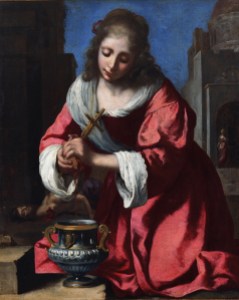
Saint Praxedis (1655), Johannes Vermeer. Kufu Company Inc. (on long-term loan to the National Museum of Western Art, Tokyo)
This is not, on the face of it, very Vermeer – and indeed, the painting, which copies an Italian work by Felice Ficherelli, is of disputed attribution, though recent investigations by Christie’s and the Rijksmuseum agree it is Vermeer’s. We are outside, in the ancient world, in the midst of history. There is no domestic hush, no window admitting a flood of light from the left; no letters, no music, no pearls.
One room and about three years later: The Milkmaid (c. 1658–59). So little is happening in this famous painting: everything stills, except the constant trickle of milk into her bowl. Both Praxedis and the maid focus on dispensing liquid into a vessel. But around this line of twisted tension, all is changed: a shift between Praxedis’s gruesome devotions and the milkmaid’s quiet task; from the saint’s treasuring of the precious blood as a relic, sustaining the faith of a persecuted people, to the sustenance of a household in the making of traditional fare, a pudding of milk, spices and old bread which was a staple of 17th-century Netherlandish kitchens. Rather than the pagan and historical framing of Saint Praxedis, the maid stands against an empty wall, which simplified across the painting’s versions. Recent infrared studies have revealed a now invisible shelf with hanging jugs and a large basket. Vermeer’s overpainting is a pledge to plainness, inviting the reader to attend not to objects, but to surface. The wall is a blank arena for the play of attention: cracks and punctures, subtleties of different white, textural unevenness, the drama of the shadow of a nail. It teeters into abstraction. Almost negligibly, a single pane of the gridded window to the left is broken, admitting a vacuous simplicity of unmediated light. That tiny lozenge of purer white lets in not just the outside air, but also a suggestion of the ultimate blankness sustaining the visible world. If Praxedis and her accoutrements emerge from the darkness of the pagan background, the maid at her work, and the objects that surround her, seem light’s distillations.
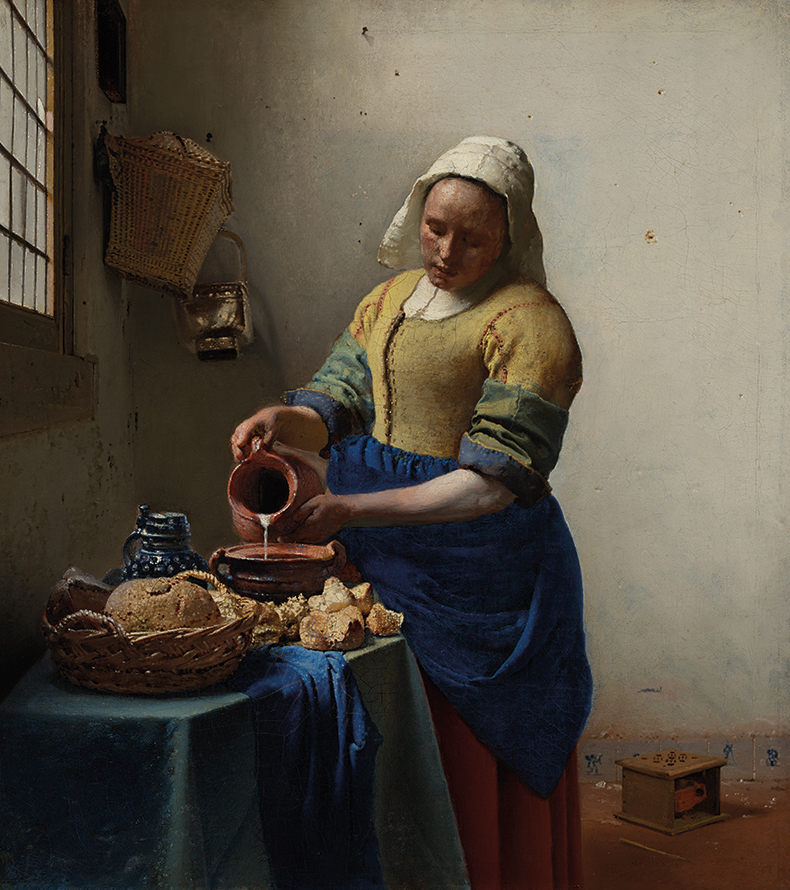
The Milkmaid (c. 1658–59), Johannes Vermeer. Rijksmuseum, Amsterdam
This exhibition, which convenes 28 of the 37 extant paintings attributed to Vermeer, is unprecedented: never before have so many of his works been brought together. Even the painter would never have had the chance to compare his works in this detail. Here, we can follow the threads of developing style and preoccupation, and allow the recurrence of motifs and objects to teach us a way of seeing. The first room places us outdoors, in Vermeer’s city context, with the beautiful View of Delft (c. 1660–61) and The Little Street (c. 1658–59); the second presents his four earliest canvases, all large-scale mythological, biblical or historical works, like Saint Praxedis; thereafter the exhibition assembles paintings in a loose chronology which also groups them by theme – music-making, letter-writing, wooing, faces, moral lessons. Though the exhibition offers context, the curators trust the paintings to the viewer, allowing the encounter with Vermeer’s way of handling paint to lead the mind to where it will.
It would be easy to take the shift from Praxedis to the milkmaid, which is also the shift from the second to the third room of this exhibition and from c. 1655 to c. 1658, as a move from apprenticeship into the full realisation of Vermeer’s particular gifts. This is both a change of subject matter – from the historical and allegorical canvases of the earliest paintings to the light-flooded domestic interiors and charismatic studies of faces, called tronies, for which he is famous – and of technique. Between these rooms Vermeer learned about perspective, probably from his contemporary Pieter de Hooch, and also studied effects of focus and blur in the visual field, possibly through other Delft acquaintances such as the lensmaker and microscopist Antoni van Leeuwenhoek. But it would be a mistake to read this move into the domestic world, and into optical theory, as secularisation and demystification. It is possible to get very technical – and several of the catalogue essays do – about the stippling, punctiform marks, and proportional relations of brightness which enable Vermeer’s extraordinary effects, and what he may have known of the camera obscura and colour saturation in order to produce them. But an explanation is not an explaining away: knowing how these paintings were achieved only deepens their strangeness in the perception of everyday things.
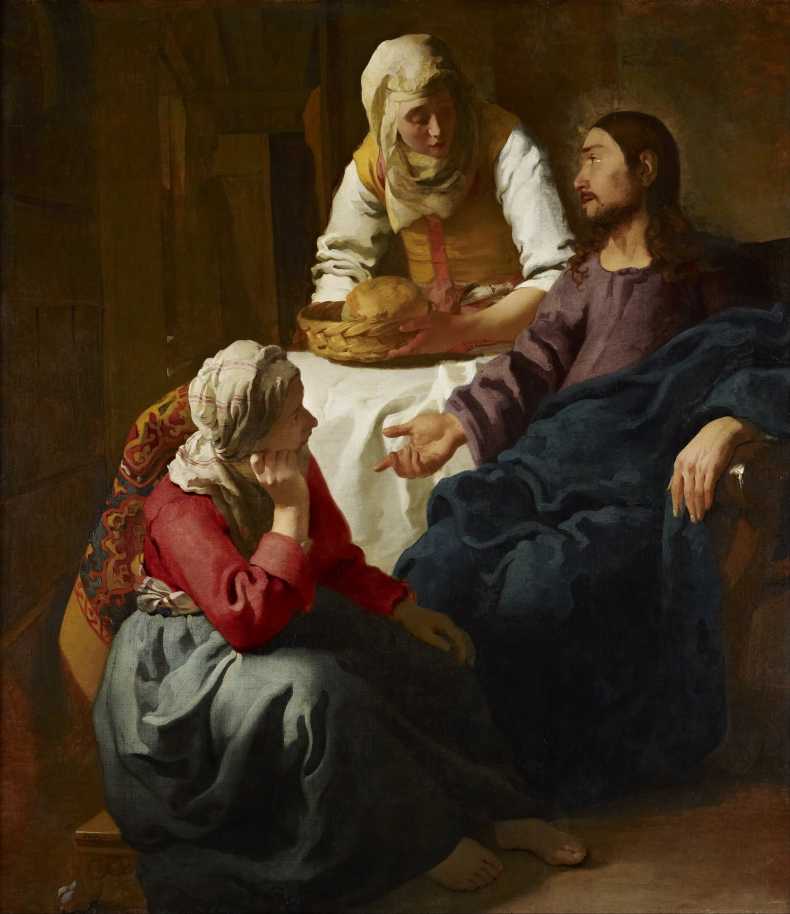
Christ in the House of Mary and Martha (c. 1654–55), Johannes Vermeer. National Galleries of Scotland, Edinburgh
Take bread. In what is probably Vermeer’s earliest extant canvas, Christ in the House of Mary and Martha, painted around 1654–55, the busy Martha interrupts her sister’s rapt attention to Jesus’s teaching and proffers him a humble loaf, the changing surface of its crust implied by rough brushstrokes, including one rather unassimilated swathe of darker colour on top of the continuity of paler brown. In The Milkmaid, the central figure combines the double roles of Mary and Martha, at once domestically active and a study of meditative focus, while the bread in the foreground has become a pointillist riot of spots and dots of blue and grey and yellow. The catalogue scrupulously points out that this is an accurate rendering of what is shown by a camera obscura: focus on the middle-ground blurs objects nearer to. But while this makes the total painting compellingly vivid, the bread becomes luridly peculiar. If the wall in the background invites attention to lose itself in pure painting, the foreground estranges the eye. The same surprising dappling of non-representational colour recurs elswhere: in the brilliant granules spotting the curtain-tapestries of The Art of Painting (c. 1666–68) and Allegory of the Catholic Faith (c. 1670–74), for example, or in the way the side of the barge moored to the right of the View of Delft glitters with light reflected from the water, as if hung with coloured bulbs.
Art historians often remark on Vermeer’s disturbance of the integrity and discreteness of things. Svetlana Alpers, in her famous study of Dutch painting of the 17th century, The Art of Describing (1983), discusses the ‘vertiginous’ experience of looking at objects in Vermeer, who ‘seems almost not to care, or not even to know, what it is that he is painting’. Gregor J.M. Weber, in a catalogue essay, claims similarly that ‘one gets the impression that Vermeer […] only paints exactly what it is that he sees – gradations of colour tones that depend on an optical focus.’ Perhaps; but for the viewer, the effect is less amazement at Vermeer’s accurate observation of the field of vision, and more an awed estrangement from the concrete, even in the middle of quotidian stuff.
In Mistress and Maid (c. 1664–67), what draws the attention is the inkpot, an edgeless thing of black which catches a riddling grid of light, reflected from windows we cannot see, dissolving from representation into pure abstraction. The pearl in the ear of the Girl with the Pearl Earring (c. 1664–67) has no edges; its contours are merely suggested by two commas of white. The most striking examples come in one of Vermeer’s last paintings, Allegory of the Catholic Faith, in which a glass globe is scarcely distinguishable from the black background against which it hangs, its presence only evident from daubs of colour which, like the earlier inkpot, at once suggest an unseen window in the room, and dissolve into unlikely and unrepresentative streaks of blue and grey and ochre. On the table beneath it stands a crucifix: the body of Christ, the central object of the faith of which this is an allegory, is minimally sketched. Underarticulated lines of dullest brown imply his arms and pendent body, while a stillicide of golden smudges suggests where light is falling.
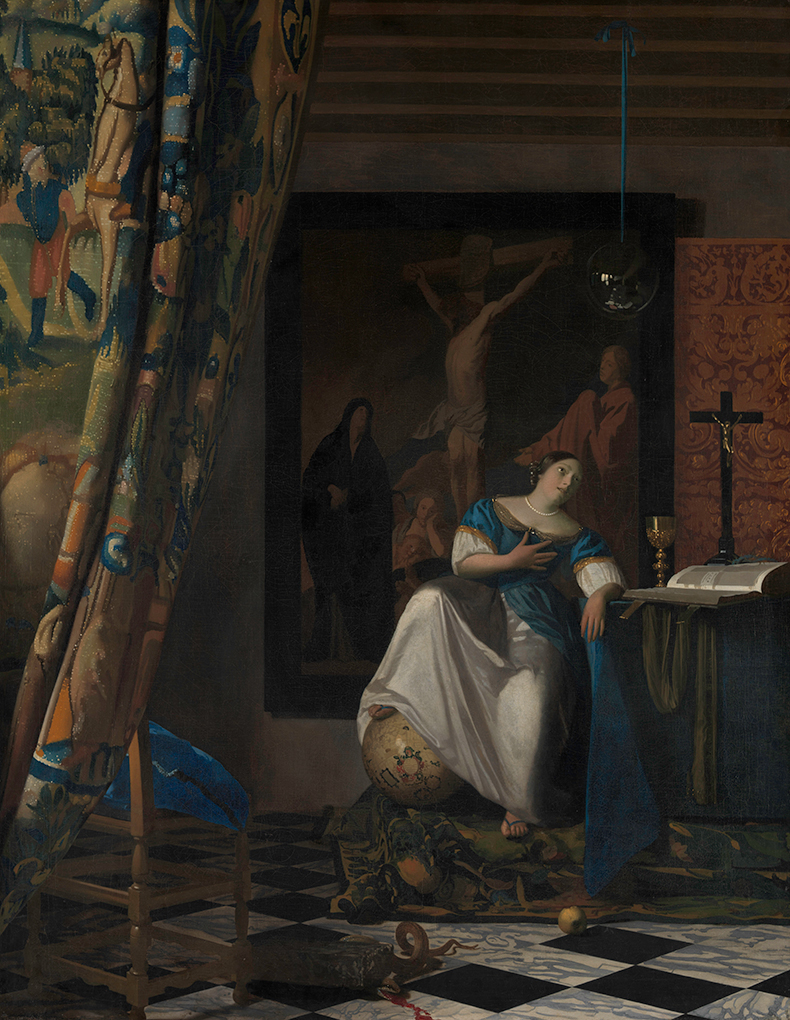
Allegory of the Catholic Faith (c. 1670–74), Johannes Vermeer. Metropolitan Museum of Art, New York.
This takes us back to the pointillist bread of The Milkmaid. The line that links the unassuming loaf in the House of Mary and Martha, to The Milkmaid, to the crucifix in Allegory of the Christian Faith, is obviously theological: the mundane substance of daily bread, by which alone man cannot live, but which, in the Mass, is consumed as a sacrament enabling the faithful to participate in the body of Christ. Vermeer converted to Catholicism on his marriage, and several catalogue essays emphasise his connection with Jesuits in his Delft neighbourhood, who were possibly his patrons, and, through their devotional literature, a source for his interest in the camera obscura. But if there is a mystery here, it is not transubstantiation, but a kind of desubstantiation, a dispersal of the substance of things. Or rather: the paintings force the viewer to realise how substantiation is born of looking, how our eyes take the unfocused, mosaic, unlikely surface of the world and read it into form.
This suggests a different way of taking the shift away from the devotional picture of Saint Praxedis and into the interiors of Vermeer’s later work. People frequently read Dutch painting of the 17th century as obsessed with vanitas – emptiness, vanity. Scarce is the museum placard, explaining a still life, which does not invoke memento mori: every fly reminds us of putrefaction, each blown tulip of worldly transience. The museum captions point to the implicit moral of paintings such as Woman Holding a Balance and Woman with a Pearl Necklace (both c. 1662–64), reading them as allegories warning that the proper lodging of value is not in the material stuff of this world but in virtue which assures passage to the next. The readings are plausible. In Woman Holding a Balance, a half-obscured painting of the Last Judgement hangs on the back wall, implying the need to consider last things; the jewellery spilling from her boxes, and the powder puff on the dressing table in Woman with a Pearl Necklace, are proverbial signals of misplaced vanity. But the overall impression of the paintings is undidactic, even devotional. In both, the light is annunciatory, coming in high from the left. The woman holding a balance is exquisitely poised, in her Marian garb, with her left hand hovering above the table, not pondering the respective weight of things, but herself holding everything in balance. The woman at her dressing table lifts her pearls in the orans position, the pose adopted when a priest prays during the Mass on behalf of the people. This does not read as secular parody, but as the sacred infusing the everyday. The need for secrecy in Catholic worship in the Protestant Dutch Republic meant that devotions were domestic: the Jesuits in Vermeer’s neighbourhood operated a clandestine church behind a household exterior. There is no equivalent, for Vermeer, of the soaring white interiors of the churches denuded by iconoclasm painted by his contemporaries Pieter Saenredam or Emanuel de Witte. The catalogue reports that the blank wall behind the woman with the pearl necklace was at first almost entirely covered in a map: the overpainting, which technical investigation suggests is original, whitewashes the wall into another beautiful study of how light suffuses a surface. Vermeer’s paintings tell us not of the puffed-up emptiness of vanity, but that apparent emptiness is a plenitude, a saturation of everything – sacred and mundane – with light.
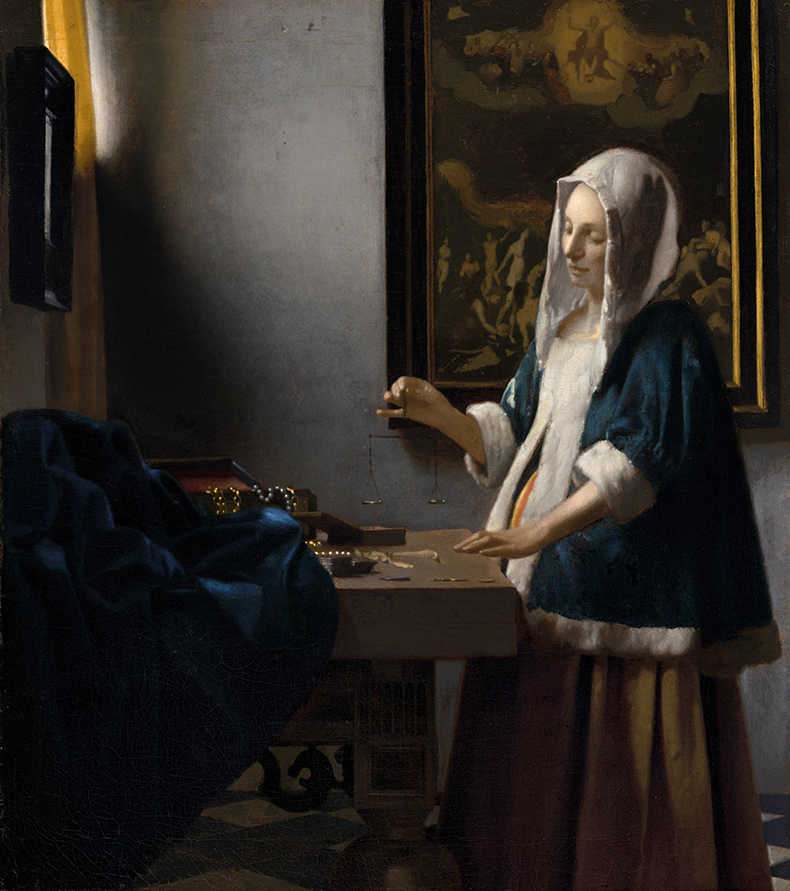
Woman with a Balance (c. 1664), Vermeer. National Gallery of Art, Washington, D.C.
The experience of this exhibition is a different sense of fullness. Publicity invites the viewer to get ‘closer to Vermeer’, a phrase which Taco Dibbits, the Rijksmuseum’s director, claims in his catalogue introduction ‘could be a motto of this exhibition’. But the invitation to closeness has been issued to hundreds of people at once. The exhibition is full of something which Vermeer never painted: crowds. When I was there, there were people at least eight deep in front of most paintings. Without perseverance, the art is glimpsed only through the screen of others’ lifted phones, the camera obscurers. Steel yourself: getting to the front requires patience, stamina and immunity to jostling. But the perseverance is worth it. Despite the press, the paintings have a power to still; to invite us to dwell on the strange surface of things and in lozenges of light, and to exercise the substantiating faculty of the eye.
‘Vermeer’ is at the Rijksmuseum, Amsterdam, until 4 June.
From the April 2023 issue of Apollo. Preview and subscribe here.
Unlimited access from just $16 every 3 months
Subscribe to get unlimited and exclusive access to the top art stories, interviews and exhibition reviews.

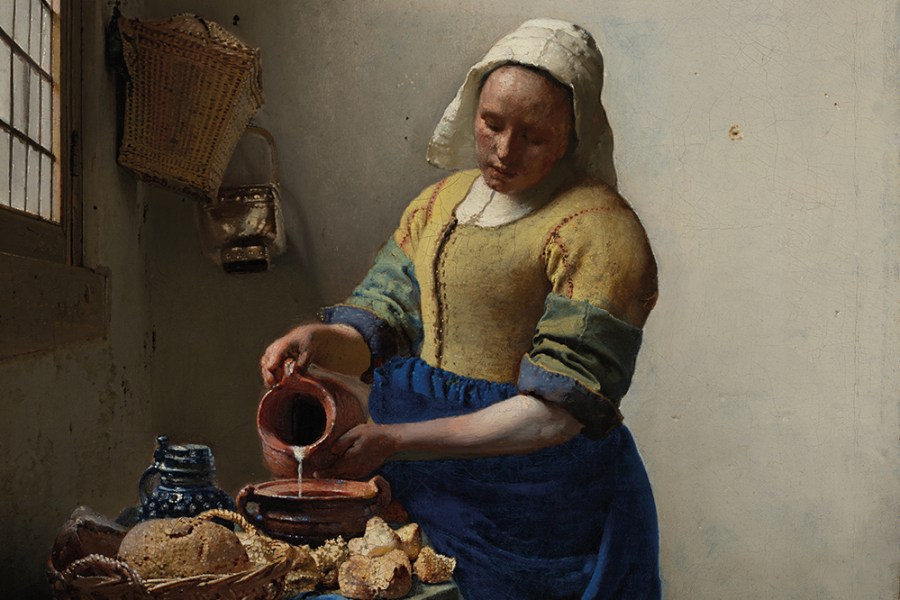
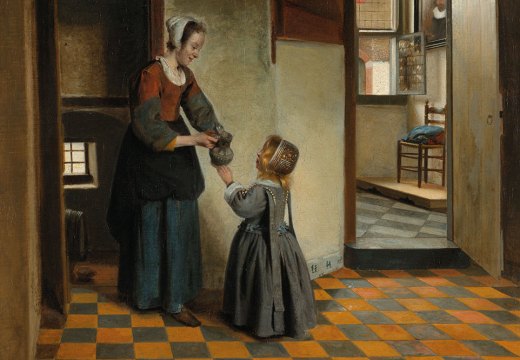
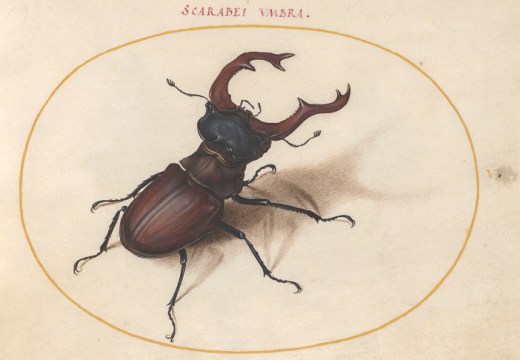
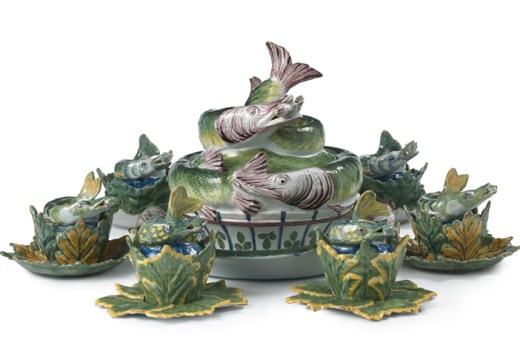









![Masterpiece [Re]discovery 2022. Photo: Ben Fisher Photography, courtesy of Masterpiece London](http://www.apollo-magazine.com/wp-content/uploads/2022/07/MPL2022_4263.jpg)
It’s time for the government of London to return to its rightful home